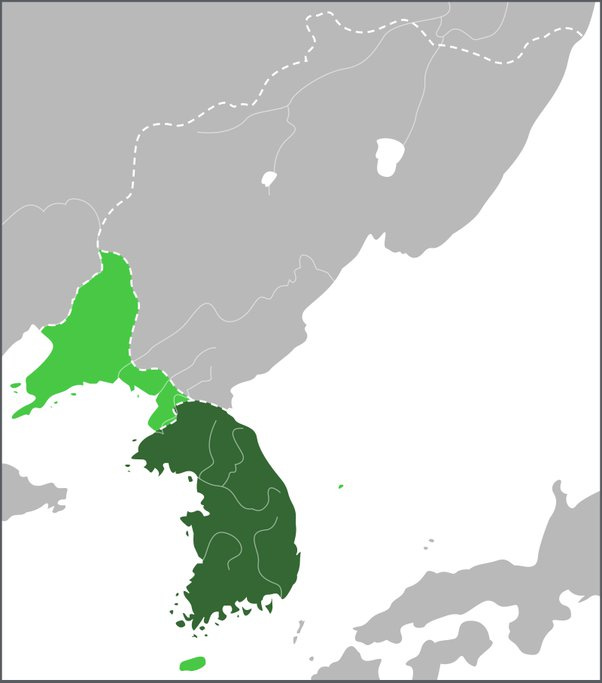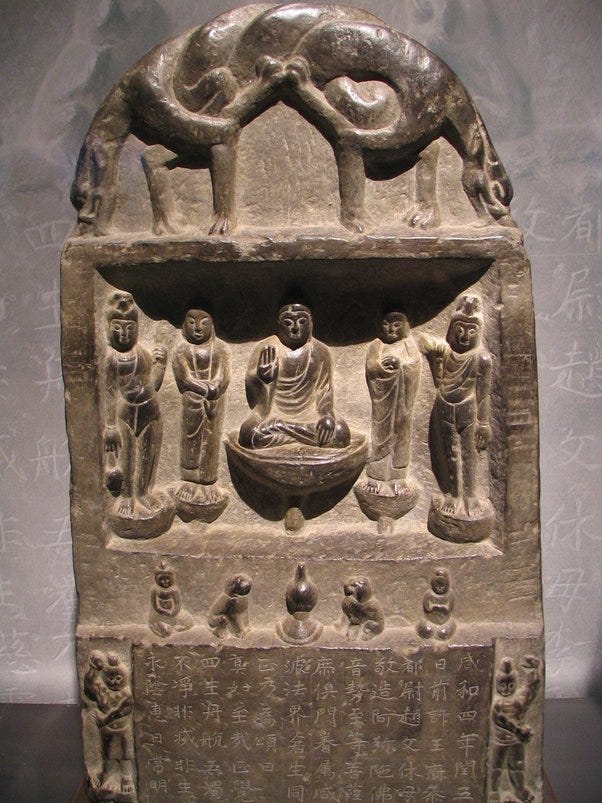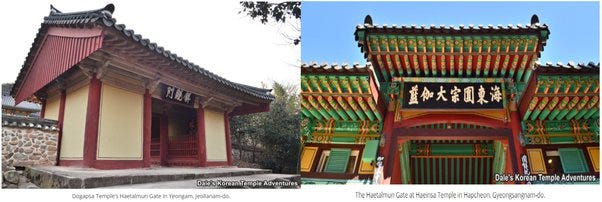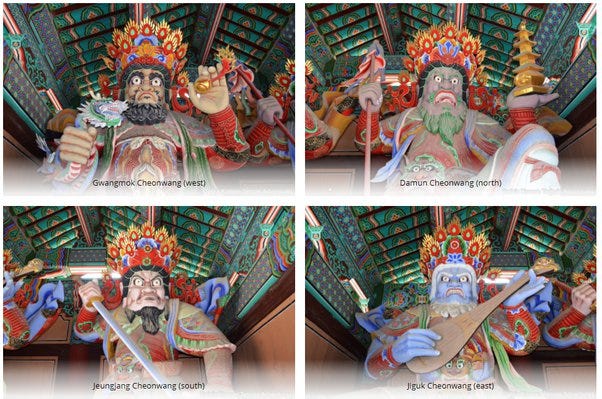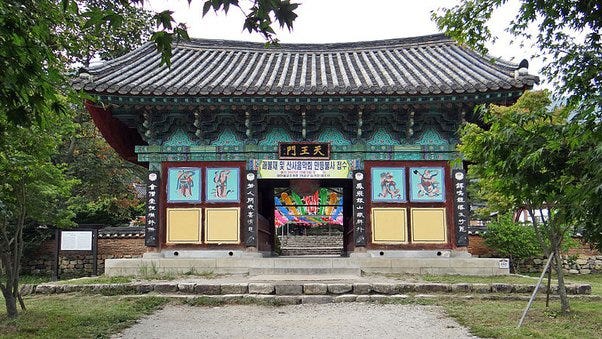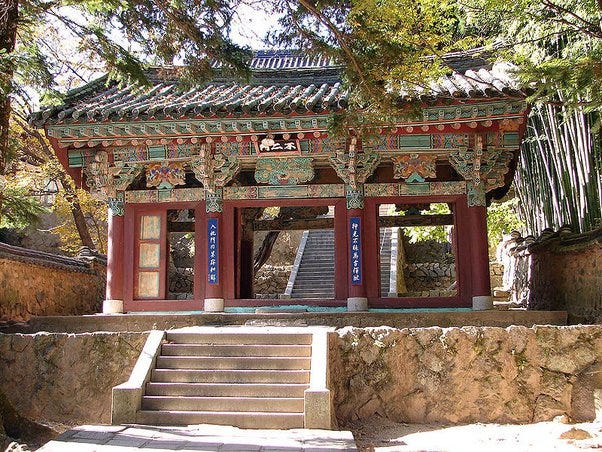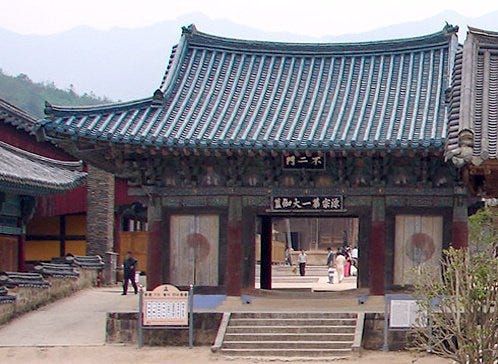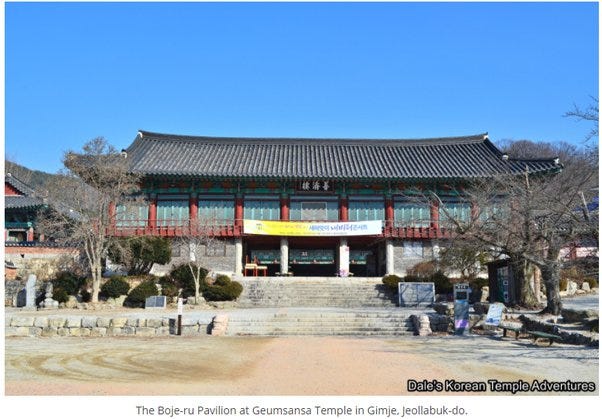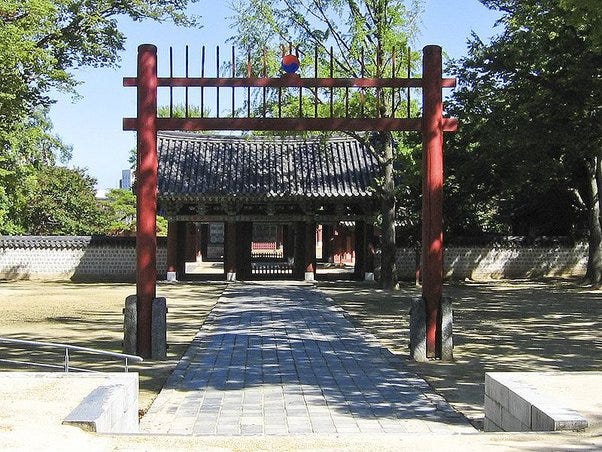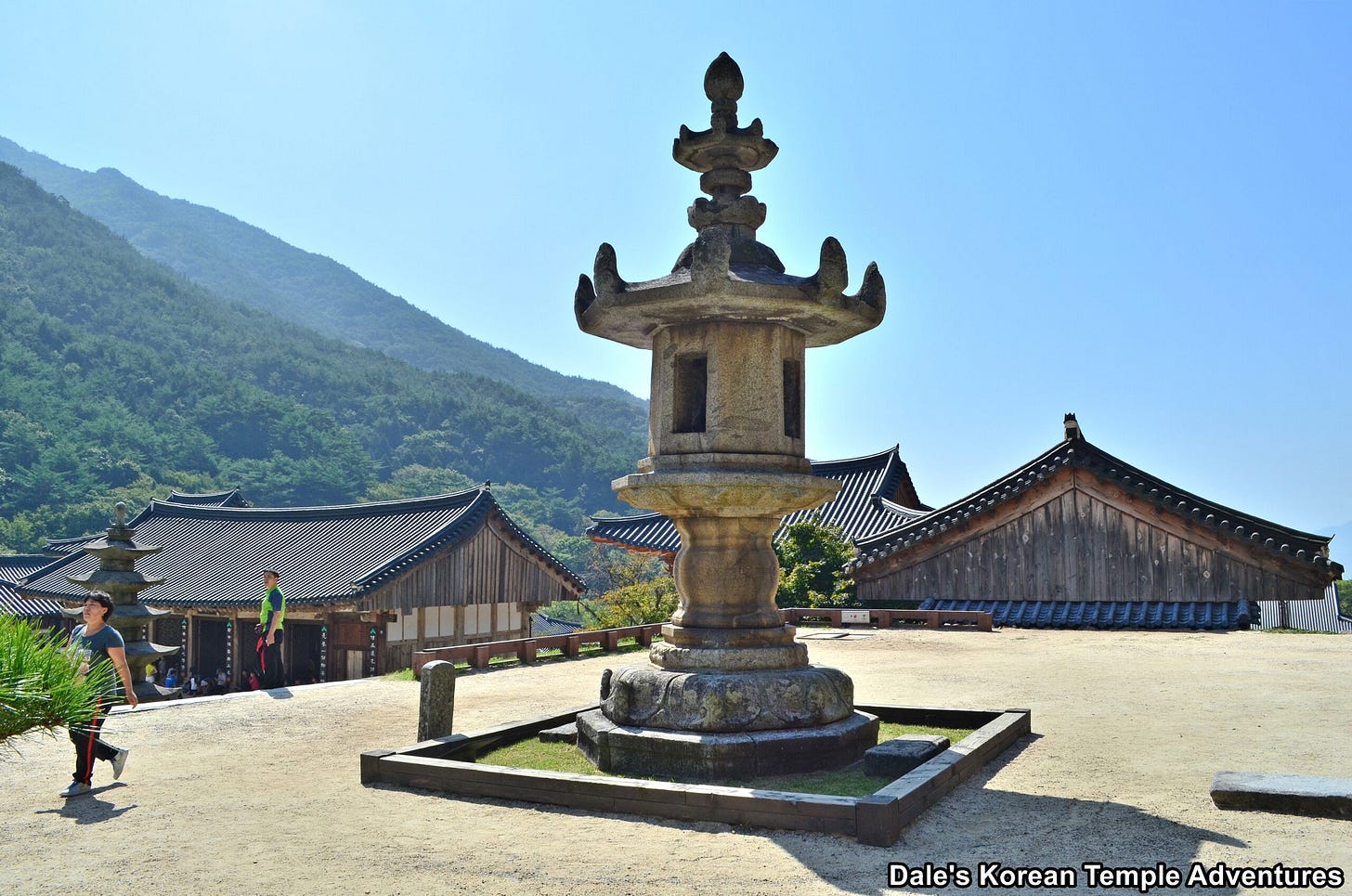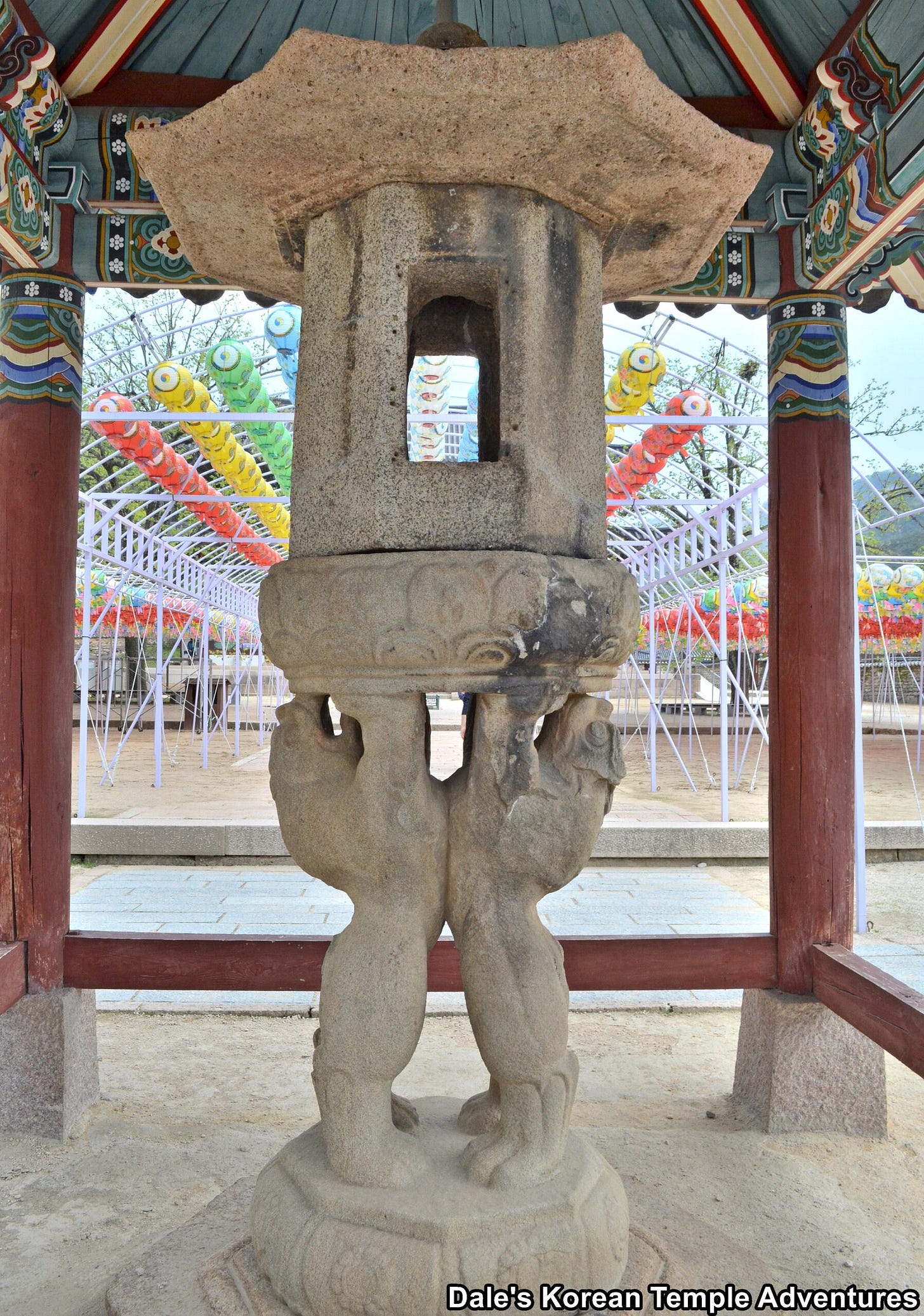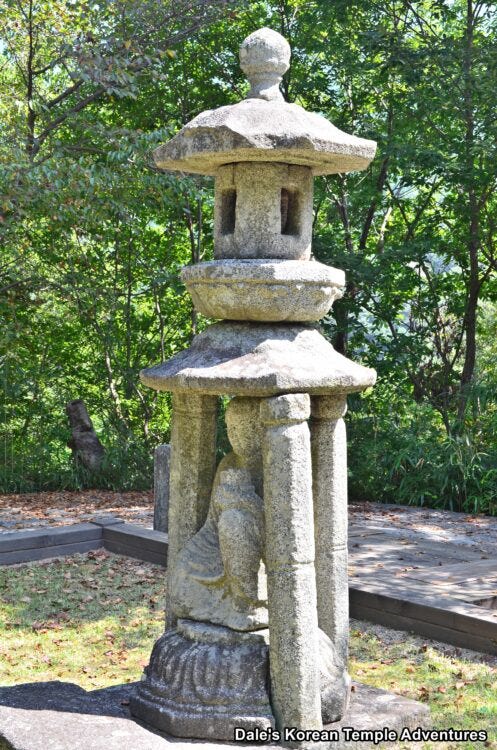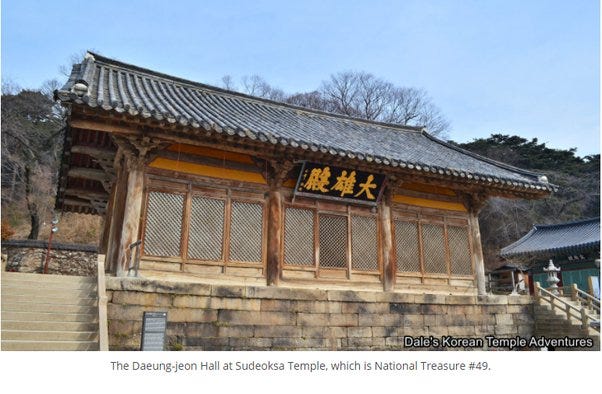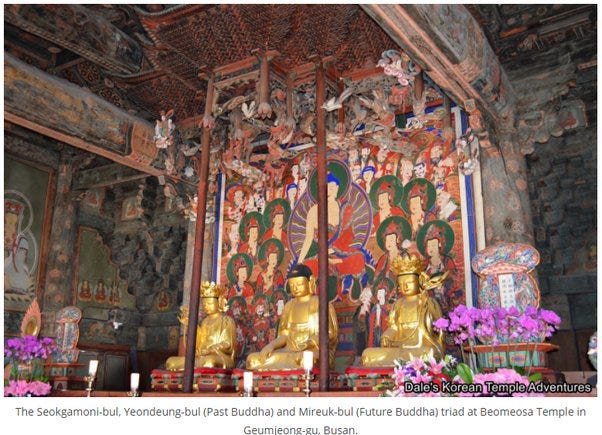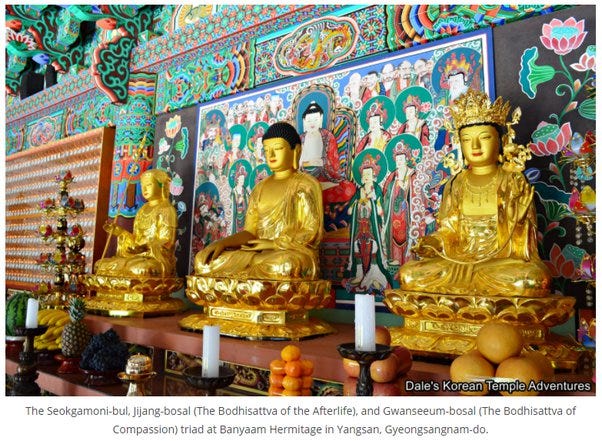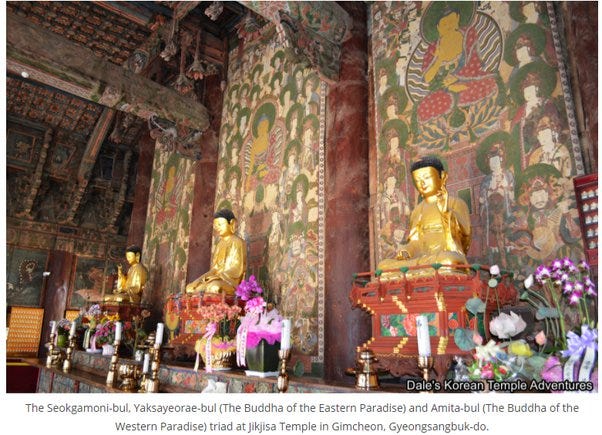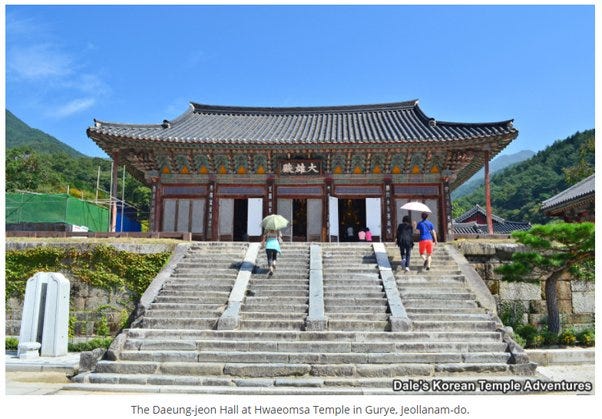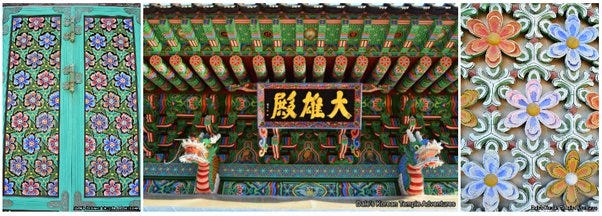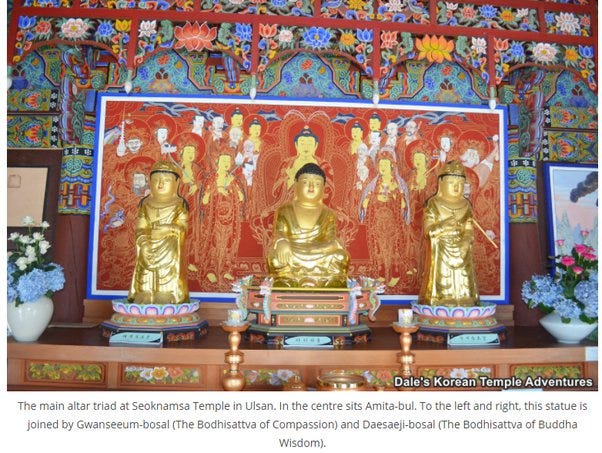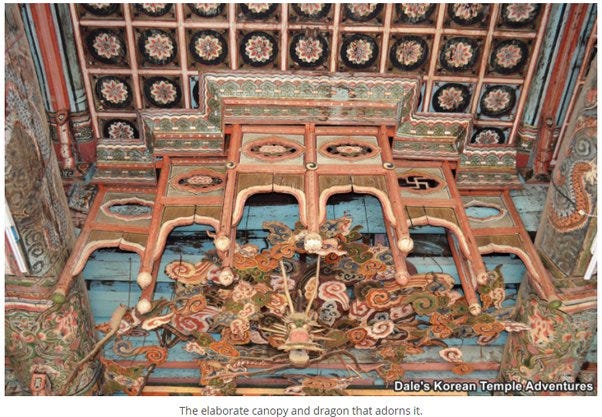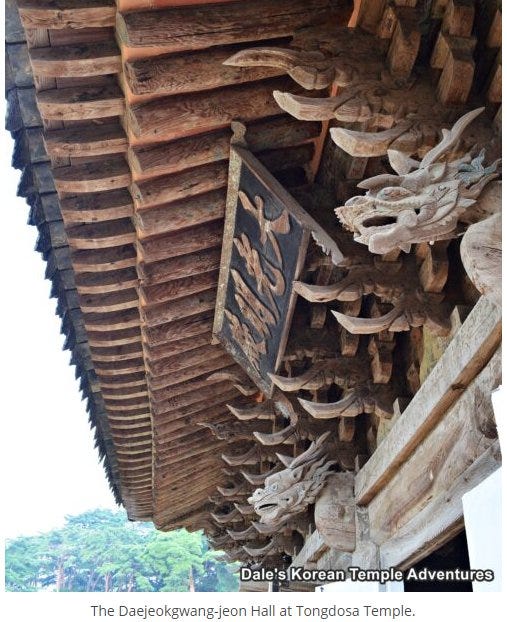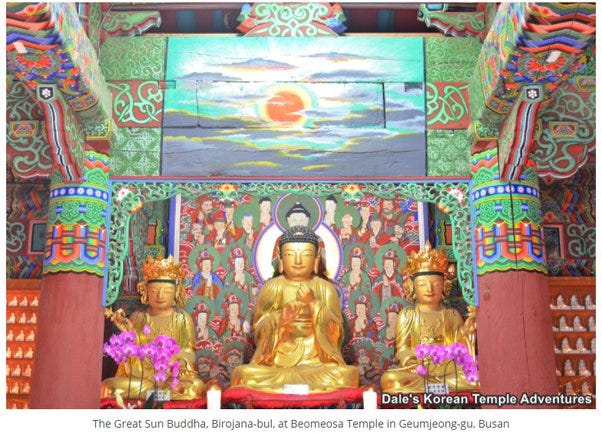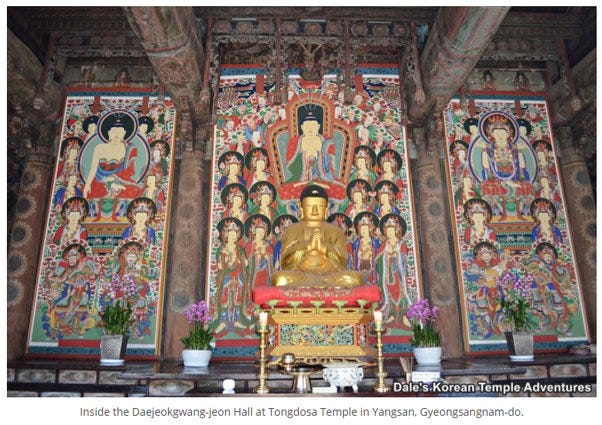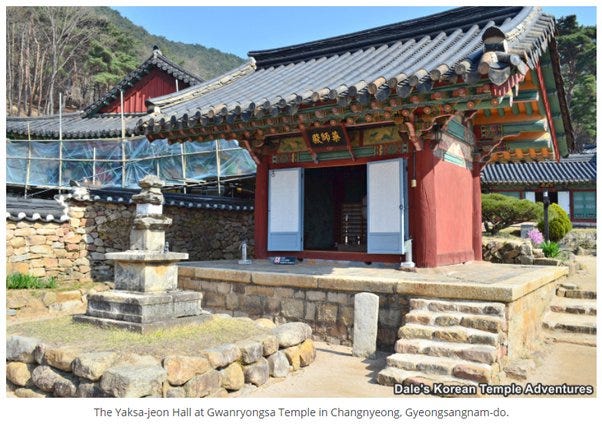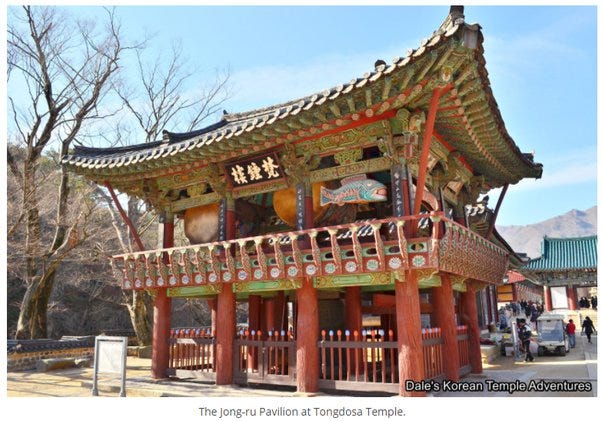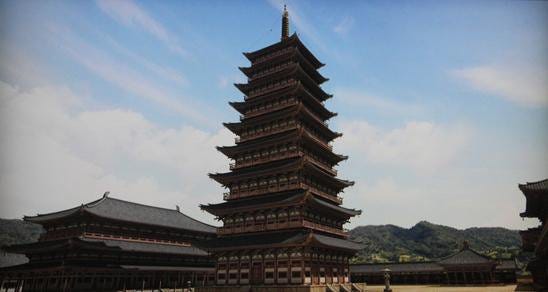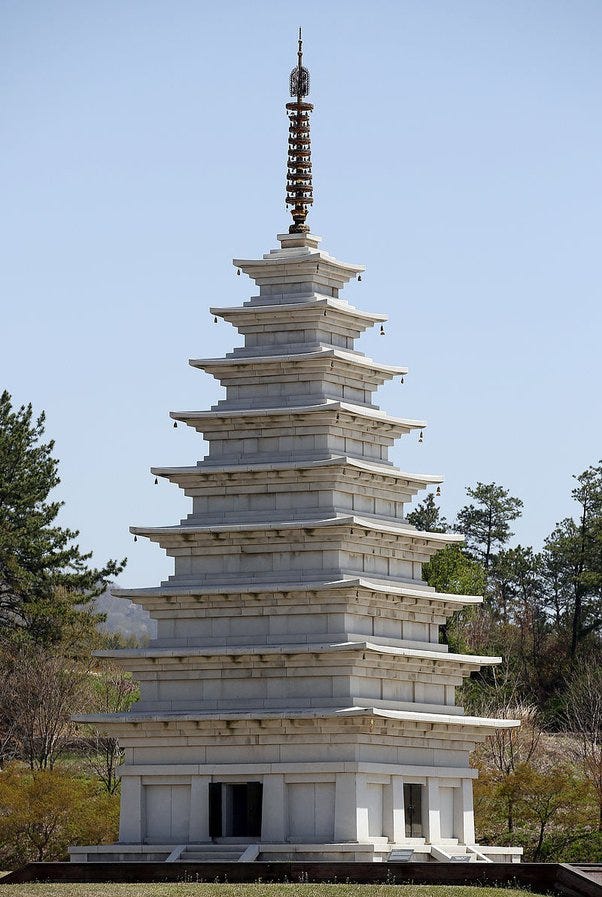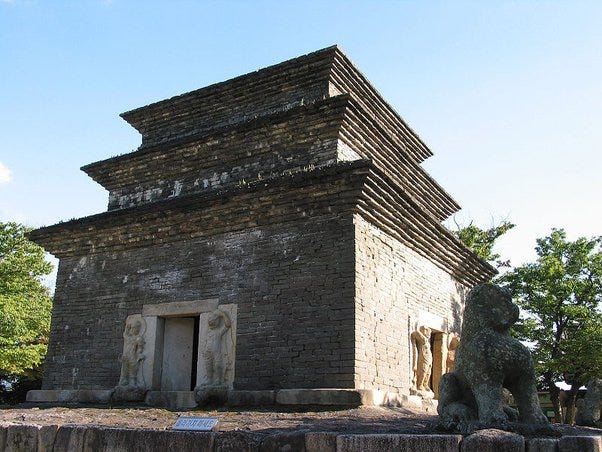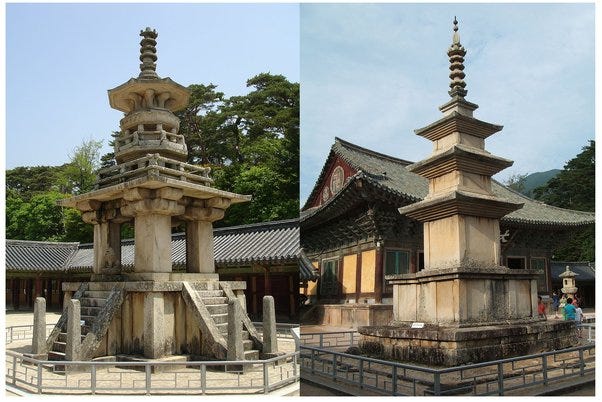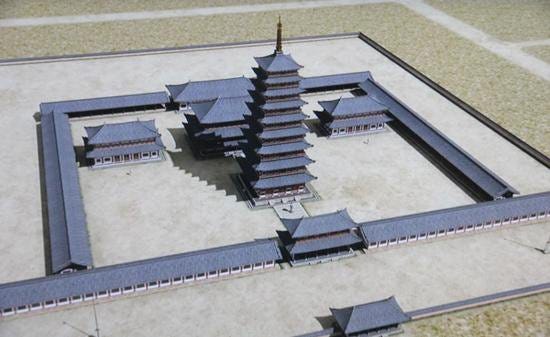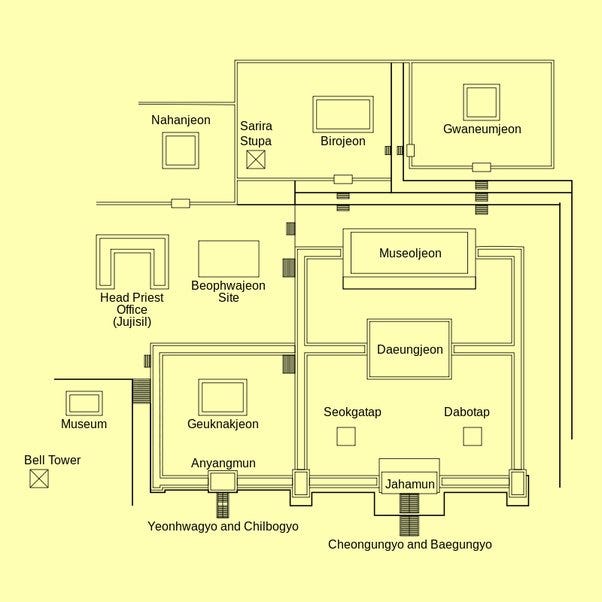Temple Architecture Styles: Joseon/Hanguk architecture
Joseon/Hanguk temple architecture developed in the historical Joseon region a.k.a. Hanguk region (Korea region : present day DPRK and RoK), and is heavily influenced by Zhōngguó Free-standing Temple Architecture. Korean architecture is characterized by naturalistic tendencies, simplicity, economy of shape, and the avoidance of extremes.
→ The post shall refer to the region as Korea henceforth.
--> In RoK, Korea as a whole is referred to as Hanguk (한국, [haːnɡuk] ; country of the Han). The name references Samhan, referring to Three Kingdoms of Korea. Although written in Hanja as 韓, 幹, or 刊, this Han has no relation to the Chinese place names or peoples who used those characters but was a phonetic transcription (OC: *Gar, MC: Han or Gan) of a native Korean word that seems to have had the meaning "big" or "great", particularly in reference to leaders. It has been tentatively linked with the title ‘khan’ used by the nomads of Manchuria and Central Asia.
--> In DPRK, Korea as a whole is referred to as Joseon (조선, [tɕosʰʌn] ; [land of the] Morning Calm). Joseon is the modern Korean pronunciation of the Hanja 朝鮮, which is also the basis of the word for Korea as a whole in Japan (朝鮮, Chōsen), China (朝鲜, Cháoxiǎn), and Vietnam (Triều Tiên). "Great Joseon" was the name of the kingdom ruled by the Joseon dynasty from 1393 CE until their declaration of the short-lived Great Korean Empire in 1897 CE. King Taejo had named them for the earlier Gojoseon (고조선; Old Joseon), who ruled northern Korea from its legendary prehistory until their conquest in 108 BCE by China's Han Empire. The Go- in Gojoseon is the Hanja 古 and simply means "ancient" or "old"; it is a modern usage to distinguish the ancient Joseon from the later dynasty. It is unclear whether Joseon was a transcription of a native Korean name (OC *T[r]awser, MC Trjewsjen) or a partial translation into Chinese of the Korean capital Asadal (아사달), whose meaning has been reconstructed as "Morning Land" or "Mountain".
Development
1st century BCE – 7th century CE
Early Three Kingdoms Period (1st century BCE – 668 CE)
Polities:
During Three Kingdoms Period (Korean: 삼국시대; Hanja: 三國時代), Korea was mainly divided between Goguryeo, Silla and Baekje. The Three Kingdoms period is usually defined as being from 57 BCE to 668 CE (but there existed about 78 tribal states in the southern region of Korean Peninsula and relatively big states like Okjeo, Buyeo, and Dongye in its northern part and Manchuria).
→ The map of Korea in 476 CE, the moment of greatest territorial expansion of Goguryeo [Source: File:History of Korea-476.PNG]
Temples:
The construction of Buddhist temples started after Buddhism was introduced in 372 CE from northern Zhōngguó.
Goguryeo Temples : Temples in some places were built in a Goguryeo style known as "three Halls-one Pagoda", with each hall in the east, west and north, and an entrance gate in the south. In most cases, the central pagodas had an octagonal plan. {Goguryeo was likely the first of the 3 kingdoms to be established}
Baekje Temples : Baekje kingdom established friendship with Zhōngguó and Nihon after the fall of Nangnang County under Han dynasty of Zhōngguó. During this time, multiple temples and pagodas were built; the earliest known stone pagoda (Mireuksa Temple’s Pagoda) is from this period showing transitional features from wooden to stone pagodas. The characteristic of Baekje architecture is its use of curvilinear designs. Though no Baekje buildings are extant - in fact, no wooden structure of any of Three Kingdoms now remains - it is possible to deduce from Horyuji temple complex in Japan, which Baekje architects and technicians helped to build, that Baekje's architecture came into full bloom after the introduction of Buddhism in 384 CE. Baekje style temple complexes fall under “one Pagoda” and "one Hall-one Pagoda" styles.
Silla Temples : Silla was the last of the three kingdoms to develop into a full-fledged kingdom. It came under Buddhist influence after 527 CE. Since its temples were separated from Zhōngguó by Goguryeo or Baekje, Zhōngguó’s cultural influence was much diluted.
7th century CE – 10th century CE
Unified Silla Dynasty (668 CE – 935 CE)
Balhae (698 CE – 926 CE)
Later Baekje (892 CE – 936 CE)
Later Goguryeo a.k.a. Taebong (901 CE – 918 CE)
Polities:
Silla conquered the other two kingdoms, Baekje in 660 CE and Goguryeo in 668 CE. Thereafter, United Silla occupied most of the Korean Peninsula.
Buddhism also flourished in the northern Korean Kingdom of Balhae, established after the fall of Goguryeo, as the state religion.
→ Unified Silla with indication of territory; Tamna and Little Goguryeo are indicated in light green [Source: File:Unified Silla.svg]
Temples:
United Silla absorbed the fully matured culture of Zhōngguó’s Táng dynasty, and simultaneously developed a unique cultural identity. New Buddhist sects were introduced from the Táng and Buddhist art flourished.
During this period, the plans of Buddhist temple complexes were characterized by 2 pagodas in front of the central main hall in a symmetrical layout on the north–south axis with other buildings. This includes Bulguksa at the foothill of Mt. Toham near Gyeongju which is the oldest existing temple in Korea.
→ Twin Pagodas of Gameunsa-ji Temple Complex in North Gyeongsang Province of RoK [Source: Dale’s Korean Temple Adventures]
Remains of 10 Buddhist temples have been found in the remains of the capital of Balhae, Sanggyeong, together with such Buddhist artifacts as Buddha statuettes and stone lanterns, which suggests that Buddhism played a predominant role in the life of the Balhae people. The Balhae tomb Majeokdal in Sinpo, South Hamgyong Province, are associated with pagodas and temples — this also indicates that Buddhism had a strong influence over the funerary rituals in Balhae.
→ Balhae in dark green [Source: File:Balhae.svg - Wikimedia Commons]
→ Buddhist relief sculpture from Balhae at Ohara Museum of Art in Japan. The inscription in Literary Chinese contains a description of the artifact's making in 834 CE, and a poem honouring the dharma. [Source: File:Pressapochista4.jpg - Wikimedia Commons]
10th century CE – 14th century CE
Goryeo Dynasty (918 CE – 1392 CE)
Polities:
The final century and a half of the Silla state was one of nearly constant upheaval and civil war as the king was reduced to little more than a figurehead and powerful aristocratic families rose to actual dominance outside the capital and royal court. The tail end of this period, called Later Three Kingdoms Period (892 CE – 936 CE), briefly saw the emergence of the kingdoms of Later Baekje and Later Goguryeo, which were really composed of military forces capitalizing on their respective region's historical background, and Silla's submission to Goryeo dynasty.
Goryeo dynasty suffered heavy invasions by Mongols in 13th century CE, leading to destruction of many pagodas.
→ Goryeo in 1374 CE [Source: File:Koryo map.png]
Temples:
Many Buddhist temples and pagodas were developed during this period based on religious needs, as Buddhism played an important role in the culture and society at the time. Unfortunately little has survived to the present day, since most of the architecture from this period was built of wood.
Few remaining wooden structures from the late Goryeo period in RoK show significantly simpler bracketing than those from the later Joseon period architecture. Bright and soft colouring of these structures had been further developed since Three Kingdoms era.
14th century CE – 20th century CE
Joseon Dynasty (1392 CE – 1910 CE)
Polities:
Joseon Kingdom was founded following the aftermath of the overthrow of Goryeo in present-day Kaesong city. Early on, Korea was retitled and the capital was relocated to modern-day Seoul.
The founding of Joseon Dynasty in 1392 CE brought to power like-minded men steeped in the doctrines of Neo-Confucianism, which had slowly percolated into Korea from China in 14th century CE. This ushered in a new environment that was relatively hostile to Buddhism, causing the state to gradually shift its patronage from Buddhist temples to Confucian institutions. Jongmyo, or memorial shrines, were established by the government to commemorate exceptional acts of filial piety or devotion.
The aesthetics of Neo-Confucianism, which favoured practicality, frugality, and harmony with nature, forged a consistent architectural style throughout Korean society.
Structural Details
Gateways
The generic name of gates in Korea is Mun (문).
Gates of Korean Buddhist complex:
A Korean Buddhist Complex can have one or more of the following types of gates.
Iljumun (일주문 ; One Pillar Gate)
Iljumun12 is the outermost gate in a Korean Buddhist temple complex. It is called "One-Pillar Gate", because when viewed from the side the gate appears to be supported by a single pillar.
It consists of a tiled roof that’s supported by 2 or 4 pillars that stand in a straight line. A wooden name plate is placed in the centre of the gate, either with the name of the temple or the neighbouring mountain written on it. These name plates are generally written in Hanja (Traditional Chinese Characters).
→ Iljumun examples:
Images from Dale's Korean Temple Adventures - showing One-Pillar Gates of (L-R) Hwaeomsa Temple Complex in Gurye, Seonamsa Temple in Suncheon and Beomeosa Temple (called Jogyemun)
Geumgangmun (금강문 ; Diamond Gate) a.k.a. Inwangmun (Virtuous King Gate) a.k.a. Haetalmun (Liberation Gate)
Geumgangmun3 is the 2nd of the entry gates in a general Korean Buddhist temple complex, and is placed between Iljumun and Cheonwangmun. It is larger in structure than Iljumun but smaller than Cheonwangmun.
**Some temple complexes, like Beomeosa complex may not have such gate with their 2nd gate being Cheonwangmun.
→ Geumgangmun examples:
Images from koreantempleguide.com showing Geumgangmun
Cheonwangmun (천왕문 ; Heavenly Kings Gate) a.k.a. Sacheonwangun (Four Heavenly Kings Gate)
Cheonwangmun4 is usually the 3rd gate in a in a general Korean Buddhist temple complex. This gate houses four figures that have intimidating stares, bulging eyes, and gnashing teeth — these figures represent the Four Heavenly Kings.
Some temple complexes like Beomeosa complex have Cheonwangmun as its 2nd gate, with no Geumgangmun.
→ Cheonwangmun examples;
Image from koreantempleguide.com showing the Four Heavenly Kings
[Source: File:Naesosa Cheonwangmun 13-04423 - Buan-gun, Jeollabuk-do, South Korea.JPG - Wikipedia]
Beomeosa Cheonwangmun [Source: File:Korea-Busan-Beomeosa 6214-07 Cheonwangmun.JPG]
Bulimun (불이문 ; Gate of Non-Duality) a.k.a. Yeolbanmun (Nirvana Gate) a.k.a. Haetalmun (Liberation Gate)
Bulimun5 is the 4th gate or less commonly the 3rd gate in a in a general Korean Buddhist temple complex; in rare cases may be called Haetalmun (Liberation Gate). These gates are usually adorned with beautiful pastoral paintings. The structure itself can look similar in design to an Iljumun in its open-pillar design like at Beomeosa; however, it can also resemble the enclosed design of a Cheonwangmun like at Tongdosa. Like Cheonwangmun and Geumgangmun, Bulimun has gabled roof supported by its pillars.
→ Bulimun examples:
Beomeosa complex has Bulimun as its 3rd gate [Source: File:Korea-Busan-Beomeosa 6221-07 Burimun.JPG]
Tongdosa complex’s Bulimun [Source: File:Korea-Tongdosa Purimun 3358a-06.jpg]
Boje-ru (보제루 ; Universal Salvation Pavilion)
Jabang-ru a.k.a. Guwang-ru a.k.a. Manse-ru (Ten Thousand Times Pavillion)
Uhwa-ru (우화루 ; Flowery Rain Pavilion)
Boje-ru, the 5th entry gate is actually a pavilion-gate. It is a 2-story structure positioned between Beopdang (main hall) and Bulimun.
Typically, the 1st story of the structure acts as the final gateway to the main temple courtyard. Traditionally, the ceiling to the first story of the structure is quite low to force visitors to stoop as a sign of humility before entering the inner sanctum of the temple grounds. The 2nd story is where monastic lectures and non-ceremonial Dharma assemblies (beophoe) are conducted simply because they are too large to be done inside the main hall.
→ Boje-ru examples:
[Source: koreantempleguide.com]
Some Boje-ru were used as protection against armed forces like the Japanese after Imjin War (1592-98) eg. Boje-ru of Okcheonsa Temple in Goseong, Gyeongsangnam-do. Specifically, it was used for military training and guarding the temple buildings from invaders. This type of pavilion is called a Jabang-ru or Guwang-ru or Manse-ru (Ten Thousand Times Pavillion). The reason that this pavilion potentially has one of these four names is that they are usually used for large conferences or gatherings to discuss the Buddhist teachings.
→ Jabang-ru examples:
[Source: koreantempleguide.com]
If a temple complex is smaller in size, or a hermitage, like the historic Geojoam Hermitage in Yeongcheon, Gyeongsangbuk-do, it’s called a Uhwa-ru (우화루 ; Flowery Rain Pavilion) since instead of being a conference hall on the second floor, it houses the four instruments that are normally housed in the temple’s bell pavilion (Jong-ru).
→ Uhwa-ru example:
Uhwa-ru of Geojoam Hermitage in Yeongcheon, Gyeongsangbuk-do, RoK [Source: koreantempleguide.com]
Hongsalmun (홍살문 ; Gate with red arrows)
It is a gate for entering a sacred place in Korea. It is arranged by 2 round poles set vertically and 2 transverse bars, without any roof or door-gate. On the middle of the upper bar there is a symbol of triśūla and taegeuk image.
Its name refers to the set of pointed spikes on its top; in the past, spikes in between columns did not exist.
Hongsalmun is usually erected to indicate Korean Confucian sites, such as shrines, tombs, and academies such as hyanggyo and seowon.
→ Hongsalmun examples:
Hongsalmun at the shrine of the clan Yi of Jeonju [Source: File:Jeonju Gyeonggi-jeon cropped version.jpg]
Seokdeung (석등; Stone lantern)
Some temple complexes may have stone lanterns6 inside.
Stone lanterns comprise a base, one or less commonly multiple columns, a square or octagonal body that may optionally be decorated. The chamber typically has 4 vertical, rectangular openings. Atop this chamber is a roof-cap.
Stone lanterns are typically made of white granite.
The construction of stone lanterns became popular during Unified Silla (668-935 CE) in the ninth century, as the spread of Seon Buddhism grew in popularity. The tradition of creating stone lanterns continued through to the early part of Joseon Dynasty. Of these historic stone lanterns, of which there are 280, only about 60 of these extant stone lanterns are well preserved with all sections of the structure still intact. And of these 60, 24 are from Unified Silla Dynasty.
Stone lanterns are usually adorned with reliefs of Four Heavenly Kings or Bōdhīsattva images. These carvings symbolise the stone lantern as representation the light of the Dharma that destroys ignorance. as well as a symbol for the teachings of the Buddha and the Dharma.
→ Stone lanterns examples:
Beomeosa Stone Lamp (Tangible Cultural Asset #16) — octagonal column support an octagonal body [Source: File:Korea-Busan-Beomeosa 3299-06 Stone Lantern.JPG]
Tongdosa Stone Lantern — square base, square column, and a 4 pillared square pavillion forming the body [Source: File:Korea-Tongdosa-12.jpg - Wikimedia Commons]
Stone Lantern at Gakhwang-jeon Hall of Hwaeomsa Complex [Source: https://koreantempleguide.com/seokdeung-stone-lantern-%ec%84%9d%eb%93%b1/]
Twin Lion columned Stone Lantern of Beopjusa Complex in Beopjusa-ro Boeun-gun North Chungcheong Province, RoK [Source: https://koreantempleguide.com/seokdeung-stone-lantern-%ec%84%9d%eb%93%b1/]
Stone lantern with 4 columns simultaneously supporting the body and acting as a pavilion housing a statue, in Hwaeomsa Complex [Source: https://koreantempleguide.com/seokdeung-stone-lantern-%ec%84%9d%eb%93%b1/]
Halls/Pavillions
One or more of the following halls/pavilions may be present in a Korean Buddhist temple complex.
Daeung-jeon (대웅전 ; Great Hero Hall) a.k.a. Daeungbo-jeon (다응보전 ; Jewelled Great Hero Hall)
Daeung-jeon
Daeungbo-jeon
Inside the Daeung-jeon / Daeungbo-jeon7 sits a centrally located statue of Seokgamoni-bul (Historical Buddha) on the main altar. Daeung-jeon / Daeungbo-jeon literally means “Great Hero Hall,” in reference to Seokgamoni-bul. As a rule, Daeung-jeon / Daeungbo-jeon is centrally located inside the temple complex.
Daeung-jeon usually houses one of the following variations:
Most common variation is Seokgamoni-bul statue sits in the central location on the main altar and two Bōdhīsattvas flank Seokgamoni-bul: the one to the left is typically Munsu-bosal (Bōdhīsattva of Wisdom) wearing a large golden crown holding a sword or a trident in his hands, the one to the right is Bohyeon-bosal (Bōdhīsattva of Power) who represents the teaching, meditation, and practice of Buddha.
Seokgamoni-bul in centre with Yeondeung-bul (Past Buddha) on the left and Mireuk-bul (Future Buddha) on the right.
Seokgamoni-bul sitting in the centre with two different Bōdhīsattvas flanking him: Jijang-bosal (Bōdhīsattva of Afterlife) and Gwanseeum-bosal (Bōdhīsattva of Compassion)
Daeungbo-jeon:
Seokgamoni-bul in centre with Amita-bul (Buddha of Western Paradise) and Yaksayeorae-bul (Medicine Buddha, as well as Buddha of Eastern Paradise) flanking him.
In Hwaeom Sect (Flower Garland Sect) of Buddhism in Korea, Birojana-bul is the primary figure inside the main hall. The best example of this can be found at Hwaeomsa Temple or Geumsansa Temple.
Housed Deities and variations —
Daeung-jeon: Seokgamoni-bul with Munsu-bosal and Bohyeon-bosal
Seokgamoni-bul statue sits in the central location on the main altar. Two Bōdhīsattvas flank Seokgamoni-bul: the one to the left is typically Munsu-bosal (Bōdhīsattva of Wisdom) wearing a large golden crown holding a sword or a trident in his hands, the one to the right is Bohyeon-bosal (Bōdhīsattva of Power) who represents the teaching, meditation, and practice of Buddha.
→ [Source: koreantempleguide.com]
→ [Source: koreantempleguide.com]
Daeung-jeon: Seokgamoni-bul with Yeondeung-bul and Mireuk-bul
Seokgamoni-bul in centre with Yeondeung-bul (Past Buddha) on the left and Mireuk-bul (Future Buddha) on the right.
→ [Source: koreantempleguide.com]
Daeung-jeon: Seokgamoni-bul with Jijang-bosal and Gwanseeum-bosal
Seokgamoni-bul sitting in the centre with two different Bōdhīsattvas flanking him: Jijang-bosal (Bōdhīsattva of Afterlife) and Gwanseeum-bosal (Bōdhīsattva of Compassion). This triad is common in smaller-sized temple complexes.
→ [Source: koreantempleguide.com]
Seokgamoni-bul with Amita-bul and Yaksayeorae-bul {found in halls termed Daeungbo-jeon}
In a Daeungbo-jeon, while the central statue remains Seokgamoni-bul, accompanying statues change. Instead of housing a statue of Munsu-bosal and Bohyeon-bosal, this type of hall houses Amita-bul (Buddha of Western Paradise) and Yaksayeorae-bul (Medicine Buddha, as well as Buddha of Eastern Paradise).
→ [Source: koreantempleguide.com]
Birojana-bul/Biro-bul
In Hwaeom Sect (Flower Garland Sect) of Buddhism in Korea, Birojana-bul is the primary figure inside the main hall. The best example of this can be found at Hwaeomsa Temple or Geumsansa Temple.
→ [Source: koreantempleguide.com]
The wooden altar that the triad sits upon is called a “Sumidan” which represents the peak of mythological Mount Sumeru, which is the peak where Buddha is enthroned. It is almost always the most ornate hall on the temple grounds. Above the triad of statues is usually an elaborate canopy that features carved dragons, birds of paradise, Bicheon (Flying Heavenly Deities), and other decorative motifs.
→ [Source: koreantempleguide.com]
The exterior of Daeung-jeon can be just as elaborate as its interior. Some of the more common paintings that adorn the exterior walls are Ox-Herding Murals (Shimu-do), The Eight Scenes of the Buddha’s Life (Palsang-do). Sometimes these two sets sit in combination on Main Buddha Hall, and sometimes only one set appears. These murals can be highly elaborate in their design or very simple. Daeung-jeon can also be adorned with various paintings of Buddhas, Bodhisattvas, guardians, deities, Bicheon, historic monks, floral patterns, and animals. Daeung-jeon typically has wooden sculptures protruding out from under the roof which can be phoenixes or dragons. These dragons, much like the entirety of Daeung-jeon, are a symbol of the cabin on Dragon Ship of Wisdom that, in Buddhist mythology, ferries the faithful to Pure Land of Paradise.
→ [Source: koreantempleguide.com]
Geukrak-jeon (극락전 ; Paradise Hall) a.k.a. Muryangsu-jeon (무량수전 ; Immeasurable Life Hall)
Geukrak-jeon/Muryangsu-jeon8 is dedicated to Amita-bul (Buddha of Western Paradise).
Amita-bul is Korean transliteration of Saṁskr̥ta Amitābha Buddha (Buddha of Immeasurable Life). Amita-bul is the overseer of Jeongto (Western Pure Land) leading to the hall’s name “Paradise Hall”. The name Muryangsu-jeon which means “Immeasurable Life Hall” is another parallel to Amita-bul.
After to the main hall, Daeung-jeon Hall, Geukrak-jeon is the second most common hall to find at a Korean temple complex.
→ [Source: koreantempleguide.com]
→ [Source: koreantempleguide.com]
→ [Source: koreantempleguide.com]
→ [Source: koreantempleguide.com]
Daejeokgwang-jeon (대적광전 ; Hall of Ultimate Silence and Light)
It is a shrine hall dedicated to Birojana-bul/Biro-bul (Buddha of Cosmic Energy). In case of Hwaeom Sect, since Biro-bul plays the central part, this hall and Great Hero Hall are the same and act as main hall.
→ [Source: koreantempleguide.com]
→ [Source: koreantempleguide.com]
Inside Daejeokgwang-jeon, Birojana-bul sits on the main altar as the central figure. Sometimes, Birojana-bul can be joined by either Amita-bul (Buddha of the Western Paradise) or Rōcana, and Seokgamoni-bul.
→ [Source: koreantempleguide.com]
→ Lone Biro-bul [Source: koreantempleguide.com]
Yaksa-jeon (약사전 ; Hall of Yaksa-bul)
This type of hall is dedicated to Yaksayeorae-bul, who in Korean Buddhism is Medicine Buddha and Buddha of Eastern Paradise.
→ [Source: koreantempleguide.com]
→ Yaksa-jeon built inside a cave [Source: koreantempleguide.com]
Housed figure and variations —
1. Lone Yaksayeorae-bul
→ [Source: koreantempleguide.com]
2. Inside a Yaksa-jeon Hall, it’s typical for Yaksayeorae-bul to appear in the centre of a triad flanked by Ilgwang-bosal (Bōdhīsattva of Sunlight) to his left and Wolgwang-bosal (Bōdhīsattva of Moonlight) to his right. Usually Ilgwang-bosal has either a red crown or a red orb in his crown, while Wolgwang-bosal has either a white crown or a white orb in his crown. Yaksayeorae-bul is associated with these two Bōdhīsattvas as he heals all disease through the light of sun and moon.
→ [Source: koreantempleguide.com]
Jong-ru (종루 ; Bell Pavilion)
A near-universal features of Korean Buddhist temple complexes, Jong-ru9 are usually one or two storied, and contain 4 percussion instruments known as Buljeon Samul.
→ [Source: koreantempleguide.com]
Tap (탑 ; Pagoda)
As with China, Japan and other nations, the term pagoda can apply to both caitya and stūpa type structures in Korea.
Most Korean pagodas were built from wood with beams cut to interlock rather than nailed together. From historical records and archaeological remains, however, they were very similar to early Nihon pagodas, being square in shape in with large, tiled eaves. Compared to their Nihon counterparts, however, it’s been surmised that Korean wooden pagoda’s were considerably larger.
→ Hwangnyongsa’s Pagoda (reconstruction below) originally was 9-storied ~80m tall and entirely made of wood. Only its foundation stones remain today [Source: File:Nine story pagoda of the Hwangryongsa.JPG]
→ Palsangjeon (Hall of Eight Pictures) located at Beopjusa is one the few surviving wooden pagodas [Source: File:Korea-Boeun-Beopjusa Palsangjeon 1782-06.JPG]
As early Korean stone pagoda’s followed similar design features, wooden pagoda’s likely tapered with each tier, more so than their Zhōngguó counterparts. Stone pagoda construction took advantage of the region’s abundant granite reserves. Korean stone pagodas were first created in Baekje during the early 7th century CE and then inherited by Later Silla.
→ Reconstruction of Dongtap (30m high), the eastern pagoda of Mireuksa, built in 602 CE Silla kingdom [Source: File:Mireuksa, Jeollabuk.jpg]
→ Caitya type Bunhwangsa pagoda based on Tang era pagodas (built 634 CE) [Source: File:Korea-Gyeongju-Bunhwangsa seoktap-04.jpg]
→ Votive pagodas examples:
Votive pagodas Dabotap [Source: File:경주 불국사 다보탑.jpg] and Seokgatap [Source: File:Seokgatap bulguksa.jpg] (both built 751 CE) of Bulguksa Complex in Gyeongju, RoK. Both stand ~11m tall and are unique among Korean pagodas
Votive pagoda resembling a stone lantern in Bulguksa [Source: File:Saritap stupa at Bulguksa-Gyeongju-Korea-01.jpg]
Gyeongcheonsa Pagoda (13.5m high, built 1348 CE) [Source: File:Korea-Seoul-National Museum Gyeongcheonsa Pagoda 0187&8-06.jpg] and Wongaksa Pagoda (12m high, built 1467 CE) [Source: File:Wongaksa05.jpg - Wikimedia Commons] were both built using marble, with the former presumably inspiring the latter. (Joseon dynasty era)
Temple Complex Layouts (Examples)
→ Reconstruction of Hwangnyongsa : “3 hall 1 pagoda” style [Source: File:Panorama of the Hwangnyongsa.jpg]
→ Layout of main complex of Bulguksa [Source: File:Bulguksa-map.svg - Wikimedia Commons]
References
Iljumum
Geumgangmun - The Diamond Gate: 금강문 - Dale's Korean Temple Adventures
Cheonwangmun Gate - The Heavenly Kings Gate: 천왕문 - Dale's Korean Temple Adventures
Bulimun - The Gate of Non-Duality: 불이문 - Dale's Korean Temple Adventures
Universal Salvation Pavilion – Boje-ru: 보제루 - Dale's Korean Temple Adventures
Daeung-jeon – Great Hero Hall: 대웅전 - Dale's Korean Temple Adventures
Geukrak-jeon - Paradise Hall: 극락전 - Dale's Korean Temple Adventures
Jong-ru - The Bell Pavilion: 종루 - Dale's Korean Temple Adventures
Tap - The Korean Pagoda: 탑 - Dale's Korean Temple Adventures
https://en.wikipedia.org/wiki/Iljumun
https://koreantempleguide.com/iljumun-the-one-pillar-gate-%EC%9D%BC%EC%A3%BC%EB%AC%B8/
https://koreantempleguide.com/geumgangmun-the-diamond-gate-%EA%B8%88%EA%B0%95%EB%AC%B8/
https://koreantempleguide.com/cheonwangmun-gate-the-heavenly-kings-gate-%EC%B2%9C%EC%99%95%EB%AC%B8/
https://koreantempleguide.com/bulimun-the-gate-of-non-duality-%EB%B6%88%EC%9D%B4%EB%AC%B8/
https://koreantempleguide.com/seokdeung-stone-lantern-%ec%84%9d%eb%93%b1/
https://koreantempleguide.com/daeung-jeon-great-hero-hall-%EB%8C%80%EC%9B%85%EC%A0%84/
https://koreantempleguide.com/geurak-jeon-paradise-hall-%EA%B7%B9%EB%9D%BD%EC%A0%84/
https://koreantempleguide.com/jong-ru-the-bell-pavilion-%EC%A2%85%EB%A3%A8/








